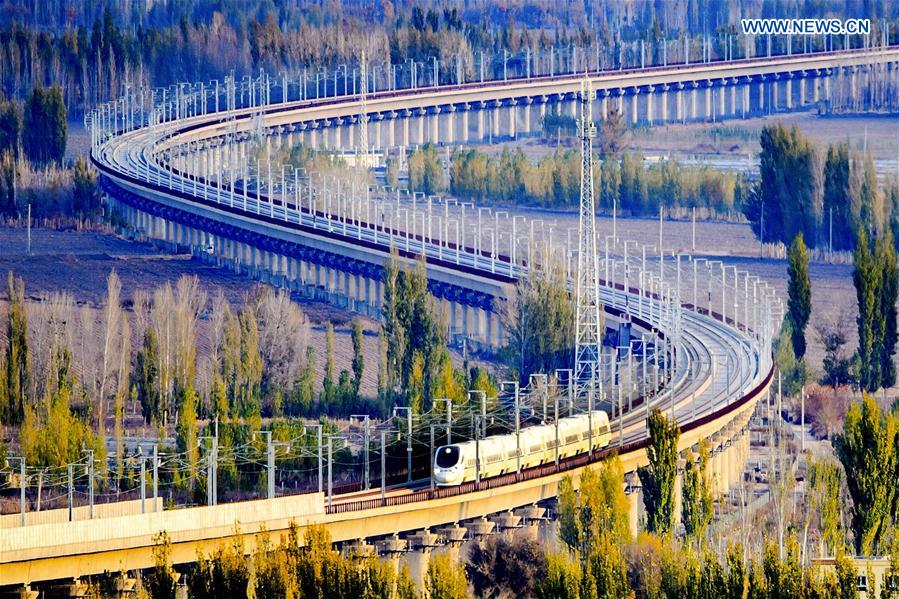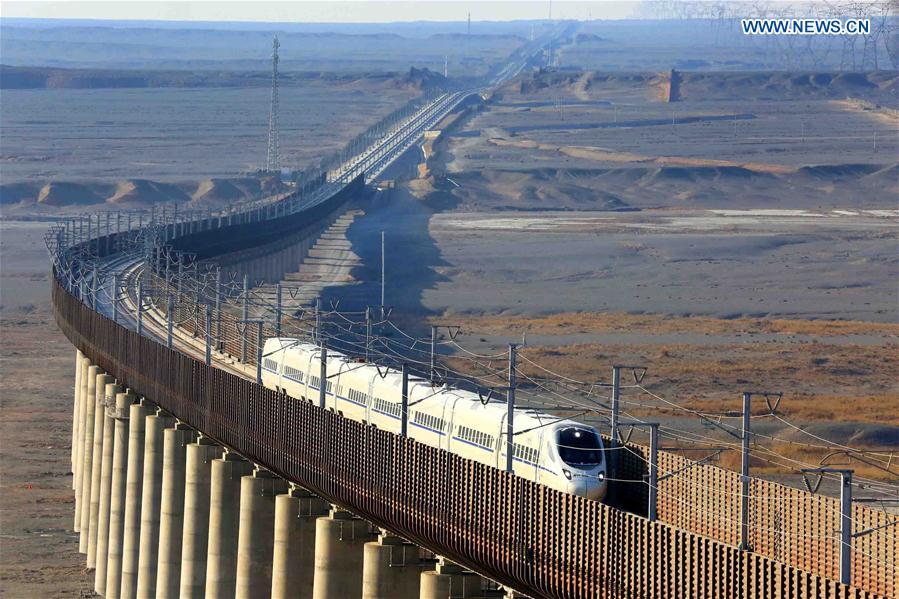In pics: high-speed rail, "name card" for China

The first train operating on Zhengzhou-Xuzhou high-speed railway stops at Shangqiu Railway Station, central China's Henan Province, Sept. 10, 2016. A new high-speed railway (HSR) line between Zhengzhou, capital of central Henan Province, and Xuzhou in eastern Jiangsu Province started its operation on Saturday, making the total length of high-speed track in the country over 20,000 km. Trains running on the 360-kilometer-long track travels at a speed of 300km per hour at the early stage of operation. [Photo/Xinhua]
Boasting low cost and quick delivery, China has built the world's longest high-speed rail (HSR) network. Branded as a "name card" for China.
HSR service debuted in China in 2008. Since then, the country has witnessed an average annual growth of over 30 percent in passenger trips, according to statistics from the China Railway Corporation. By 2016, there had been more than 5 billion passenger trips on China's bullet trains in eight years.

Fuxing train C2001 is seen arriving at Tianjin Railway Station, Aug. 21, 2017. China's new-generation bullet trains, the Fuxing, were put into operation on the Beijing-Tianjin Intercity Railway Aug. 21. [Photo/Xinhua]

The G4136 train runs on the Shuitongmuzhai bridge of the Shanghai-Kunming high-speed railway in Anshun, southwest China's Guizhou Province, Dec. 28, 2016. China on Wednesday put into operation one of the world's longest high-speed railways, linking the country's prosperous eastern coast to the less-developed southwest. The Shanghai-Kunming line -- 2,252 km in length -- traverses the five provinces of Zhejiang, Jiangxi, Hunan, Guizhou and Yunnan and cuts travel time from Shanghai to Kunming from 34 to 11 hours, according to China Railway Corporation. [Photo/Xinhua]

The G4136 train runs on the Shuitongmuzhai bridge of the Shanghai-Kunming high-speed railway in Anshun, southwest China's Guizhou Province, Dec. 28, 2016. China on Wednesday put into operation one of the world's longest high-speed railways, linking the country's prosperous eastern coast to the less-developed southwest. The Shanghai-Kunming line -- 2,252 km in length -- traverses the five provinces of Zhejiang, Jiangxi, Hunan, Guizhou and Yunnan and cuts travel time from Shanghai to Kunming from 34 to 11 hours, according to China Railway Corporation. [Photo/Xinhua]

File photo taken on Feb. 14, 2015 shows a CRH2G bullet train running for a test on the Harbin-Dalian high-speed railway, northeast China. "Building more high-speed railways" has been a hot topic at the annual sessions of China's provincial legislatures and political advisory bodies intensively held in January. China has the world's largest high-speed rail network, with the total operating length reaching 19,000 km by the end of 2015, about 60 percent of the world's total. The expanding high-speed rail network is offering unprecedented convenience and comfort to travelers, and boosting local development as well. Chinese companies have developed world-leading capabilities in building high-speed railways in extreme natural conditions. High-speed railway routes across China have been designed to suit its varying climate and geographical conditions. The Harbin-Dalian high-speed railway travels through areas where the temperature drops to as low as 40 degree Celsius below zero in winter, the Lanzhou-Xinjiang railway passes through the savage Gobi Desert and the Hainan Island railway can withstand a battering from typhoons. The China Railway Corp. plans to spend another 800 billion yuan (around 120 billion U.S. dollars) in 2016, especially in less-developed central and western regions. [Photo/Xinhua]

File photo taken on Nov. 3, 2015 shows a bullet train running through a bridge on the Lanzhou-Xinjiang high-speed railway, northwest China's Xinjiang Uygur Autonomous Region. "Building more high-speed railways" has been a hot topic at the annual sessions of China's provincial legislatures and political advisory bodies intensively held in January. China has the world's largest high-speed rail network, with the total operating length reaching 19,000 km by the end of 2015, about 60 percent of the world's total. The expanding high-speed rail network is offering unprecedented convenience and comfort to travelers, and boosting local development as well. Chinese companies have developed world-leading capabilities in building high-speed railways in extreme natural conditions. High-speed railway routes across China have been designed to suit its varying climate and geographical conditions. The Harbin-Dalian high-speed railway travels through areas where the temperature drops to as low as 40 degree Celsius below zero in winter, the Lanzhou-Xinjiang railway passes through the savage Gobi Desert and the Hainan Island railway can withstand a battering from typhoons. The China Railway Corp. plans to spend another 800 billion yuan (around 120 billion U.S. dollars) in 2016, especially in less-developed central and western regions. [Photo/Xinhua]

File photo taken on Nov. 15, 2014 shows a bullet train running on the Lanzhou-Xinjiang high-speed railway, northwest China. "Building more high-speed railways" has been a hot topic at the annual sessions of China's provincial legislatures and political advisory bodies intensively held in January. China has the world's largest high-speed rail network, with the total operating length reaching 19,000 km by the end of 2015, about 60 percent of the world's total. The expanding high-speed rail network is offering unprecedented convenience and comfort to travelers, and boosting local development as well. Chinese companies have developed world-leading capabilities in building high-speed railways in extreme natural conditions. High-speed railway routes across China have been designed to suit its varying climate and geographical conditions. The Harbin-Dalian high-speed railway travels through areas where the temperature drops to as low as 40 degree Celsius below zero in winter, the Lanzhou-Xinjiang railway passes through the savage Gobi Desert and the Hainan Island railway can withstand a battering from typhoons. The China Railway Corp. plans to spend another 800 billion yuan (around 120 billion U.S. dollars) in 2016, especially in less-developed central and western regions. [Photo/Xinhua]

Aerial photo taken on Dec. 16, 2016 shows a bullet train running in a trial operation on the Beipanjiang River Bridge of the 2,266-kilometer Shanghai-Kunming high-speed railway in southwest China's Guizhou Province. The railway linking Shanghai in east China and Kunming, capital of southwest China's Yunnan Province, is planned to be put into operation at the end of this month. [Photo/Xinhua]
Your Comment
Name E-mailRelated News
-
;
Based in Lhasa, Tibet Vista is a Tibet travel agency that specialized in Tibet permit, and Tibet tours for both private and group travelers at a local price!
•4 Days Lhasa City Group Tour from USD 460 •8 Days Everest Base Camp Group Tour from USD 850 •15 Days Mt.Kailash Group Tour from USD 1780 •2016 Tibet Train Tours from Beijing, Shanghai, Chengdu, Xining,etc




